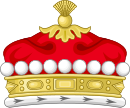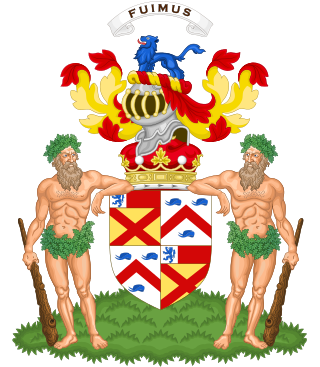
Marquess of Ailesbury, in the County of Buckingham, is a title in the Peerage of the United Kingdom. It was created on 17 July 1821 for Charles Brudenell-Bruce, 2nd Earl of Ailesbury.

Earl Howe is a title that has been created twice in British history, for members of the Howe and Curzon-Howe family respectively. The first creation, in the Peerage of Great Britain, was in 1788 for Richard Howe, 4th Viscount Howe, but it became extinct upon his death in 1799. The second creation, in the Peerage of the United Kingdom, was in 1821 for Richard Curzon-Howe, 2nd Viscount Curzon, and it remains extant.
Viscount Harberton, of Carbery in the County of Kildare is a title in the Peerage of Ireland. It was created on 5 July 1791 for Arthur Pomeroy, 1st Baron Harberton, who had previously represented County Kildare in the Irish House of Commons. He had already been created Baron Harberton, of Carbery in the County of Kildare, on 10 October 1783, also in the Peerage of Ireland. As of 2023 the titles are held by his descendant, the eleventh Viscount, who succeeded his uncle in 2004.

Viscount Hanworth, of Hanworth in the County of Middlesex, is a title in the Peerage of the United Kingdom.
Viscount Rochdale, of Rochdale in the County Palatine of Lancaster, is a title in the Peerage of the United Kingdom. It was created on 20 January 1960 for John Kemp, 2nd Baron Rochdale. He was Chairman of the woollen manufacturing firm of Kelsall & Kemp Ltd and a former President of the National Union of Manufacturers and Governor of the BBC. The title of Baron Rochdale, of Rochdale in the County Palatine of Lancaster, was created in the Peerage of the United Kingdom on 14 February 1913 for his father, George Kemp. He was Chairman of Kelsall & Kemp Ltd, a Brigadier-General in the Army, and former Member of Parliament for South East Lancashire and Manchester North West. As of 2022 the titles are held by his grandson, the third Viscount, who succeeded his father in 2015.

Viscount Buckmaster, of Cheddington in the County of Buckingham, is a title in the Peerage of the United Kingdom. It was created in 1933 for the lawyer and Liberal politician and former Lord Chancellor, Stanley Buckmaster, 1st Baron Buckmaster. He had already been created Baron Buckmaster, of Cheddington in the County of Buckingham, in 1915, also in the Peerage of the United Kingdom. His grandson, the third Viscount Buckmaster left school to join the British military's Royal Sussex Regiment branch during World War II. In 1940 he received commission and served in the Middle East, he subsequently was granted and honorary rank of Captain, he moved on to new roles in government from 1953. The viscount was appointed an Officer of the Order of the British Empire (OBE) in the 1979 Birthday Honours and was a diplomat working in the foreign office between 1946-1981 working in the middle east and Africa. As of 2017 the titles are held by the latter's nephew, the fourth Viscount, who succeeded in 2007.

Baron Churchill, of Wychwood in the County of Oxford, is a title in the Peerage of the United Kingdom and held by a branch of the Spencer family. It was created in 1815 for Lord Francis Spencer, younger son of the 4th Duke of Marlborough. He had previously represented Oxfordshire in Parliament.

Viscount Chilston, of Boughton Malherbe in the County of Kent, is a title in the Peerage of the United Kingdom. It was created in 1911 for the Conservative politician and former Home Secretary, Aretas Akers-Douglas. The title derives from Chilston Park, Akers-Douglas's country house in Kent. He was made Baron Douglas of Baads, in the County of Midlothian, at the same time, also in the Peerage of the United Kingdom. His son, the second Viscount, served as British Ambassador to Russia from 1933 to 1938. He was succeeded by his eldest surviving son, the third Viscount. As of 2010 the titles are held by the latter's first cousin once removed, the fourth Viscount, who succeeded in 1982. He is the grandson of the Hon. George Alexander Akers-Douglas, second son of the first Viscount.
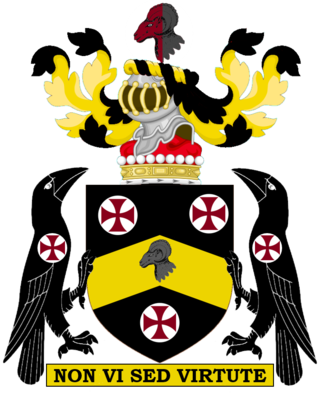
Viscount Soulbury, of Soulbury in the County of Buckingham, is a title in the Peerage of the United Kingdom. It was created on 16 July 1954 for the Conservative politician Herwald Ramsbotham, 1st Baron Soulbury at the end of his term as Governor-General of Ceylon. He was son of Herwald, son of James and brother of Rev Alexander Ramsbotham. He had already been created Baron Soulbury, of Soulbury in the County of Buckingham, on 6 August 1941, also in the Peerage of the United Kingdom. He was succeeded by his elder son, James, the second Viscount, who lived most of his life in Sri Lanka and gave his maiden speech 13 December 1984. The second Viscount was succeeded by his younger brother, Peter. Better known as Sir Peter Ramsbotham, he was a distinguished diplomat and notably served as British Ambassador to the United States between 1974 and 1977. Sir Peter's son, Oliver, fourth Viscount, succeeded in 2010.

Baron Hardinge of Penshurst, in the County of Kent, is a title in the Peerage of the United Kingdom. It was created in 1910 for the diplomat the Hon. Sir Charles Hardinge, Viceroy and Governor-General of India from 1910 to 1916. He was the second son of Charles Hardinge, 2nd Viscount Hardinge. His son, the second Baron, served as private secretary to both King Edward VIII and King George VI.

Baron Grenfell, of Kilvey in the County of Glamorgan, is a title in the Peerage of the United Kingdom. It was created on 15 July 1902 for the military commander Sir Francis Grenfell. His eldest son, the second Baron, was Deputy Speaker of the House of Lords and Chairman of Committees from 1963 to 1976. As of 2010 the title is held by the latter's son, the third Baron, who succeeded in 1976. He previously worked for the World Bank. Lord Grenfell lost his seat in the House of Lords after the passing of the House of Lords Act 1999. However, in 2000 he was made a life peer as Baron Grenfell of Kilvey, of Kilvey in the County of Swansea, and was able to return to the House of Lords.
Baron Gainford, of Headlam in the County Palatine of Durham, is a title in the Peerage of the United Kingdom. It was created on 3 January 1917 for the Liberal politician Jack Pease, a member of the Darlington Pease family. He notably served as President of the Board of Education from 1911 to 1915. Pease was the second son of Sir Joseph Pease, 1st Baronet, and the grandson of Joseph Pease, while Arthur Pease was his uncle and Sir Arthur Pease, 1st Baronet, Beaumont Pease, 1st Baron Wardington, and Herbert Pease, 1st Baron Daryngton, were his first cousins. The third baron was a former member of the London County Council and of the Greater London Council. As of 2013 the title is held by his younger brother, the fourth baron, an architect and town planner; County Planning Officer for Ross and Cromarty 1967–1975 and Scottish Office Inquiry Reporter 1978–1993.
Baron Gisborough, of Cleveland in the County of York, is a title in the Peerage of the United Kingdom. It was created in 1917 for the Conservative politician Richard Chaloner, who had previously represented Westbury and Abercromby in the House of Commons. Born Richard Long, the son of Richard Penruddocke Long, he had assumed by royal licence the surname of Chaloner in lieu of Long in 1881, as a condition of inheriting the Guisborough estate and Gisborough Hall from his maternal great-uncle, Admiral Thomas Chaloner. The latter was a descendant through his mother of Robert de Brus, who founded Gisborough Priory in 1119. Lord Gisborough's eldest son and heir, Richard Godolphin Hume Long Chaloner, was accidentally killed in France in 1917 while guarding German prisoners of war, and is buried at Calais. Lord Gisborough was therefore succeeded by his second son, the second Baron. As of 2011, the title is held by the latter's son, the third Baron, who succeeded in 1951. He notably served as Lord Lieutenant of Cleveland from 1981 to 1996. The title remains strongly linked with the town of Guisborough.
Baron Gridley, of Stockport in the County Palatine of Chester, is a title in the Peerage of the United Kingdom. It was created on 10 January 1955 for the Conservative politician Sir Arnold Gridley, who had earlier represented Stockport and Stockport South in the House of Commons. As of 2010 the title is held by his grandson, the third Baron, who succeeded his father in 1996.
Baron Addington, of Addington in the County of Buckingham, is a title in the Peerage of the United Kingdom. It was created on 22 July 1887 for the businessman and Conservative Member of Parliament, John Hubbard. He was head of the firm of John Hubbard & Co and also sat as a Member of Parliament for Buckingham and the City of London. His eldest son, the second Baron, was a partner in the family firm and represented Buckingham in the House of Commons as a Conservative. He was succeeded by his eldest son, the third Baron. He was three times Mayor of Buckingham. On the death of his younger brother, the fourth Baron, the line of the eldest son of the first Baron failed. The title passed to their first cousin once removed, the fifth Baron. He was the grandson of Cecil John Hubbard, third son of the first Baron. As of 2018, the title is held by his eldest son, the sixth Baron. He is one of the ninety elected hereditary peers that remain in the House of Lords after the passing of the House of Lords Act of 1999. Lord Addington sits on the Liberal Democrat benches.
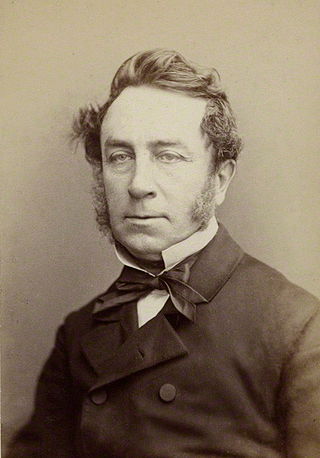
Baron O'Hagan, of Tullahogue in the County of Tyrone, is a title in the Peerage of the United Kingdom. It was created on 14 June 1870 for Sir Thomas O'Hagan, then Lord Chancellor of Ireland. His younger son, the third Baron, served as a Lord-in-waiting from 1907 to 1910 in the Liberal administrations of Sir Henry Campbell-Bannerman and H. H. Asquith and was later a Deputy Speaker of the House of Lords. In 1909 Lord O'Hagan assumed by Royal licence the additional surname of Towneley, which was that of his maternal grandfather. As of 2010 the title is held by his grandson, the fourth Baron, who succeeded in 1961. He is the son of the Hon. Thomas Anthony Edward Towneley Strachey. Lord O'Hagan was a Member of the European Parliament for Devon from 1973 to 1975 and again from 1979 to 1994, first as an independent and later as a Conservative. He assumed in 1938 by deed poll the additional Christian name of Towneley and the surname of Strachey in lieu of his patronymic. Strachey was the surname of his maternal grandfather Edward Strachey, 1st Baron Strachie.
Baron Bradbury, of Winsford in the County of Chester, is a title in the Peerage of the United Kingdom. It was created on 28 January 1925 for the economist and public servant Sir John Bradbury. He was Joint Permanent Secretary to the Treasury from 1913 to 1919 and considered to be the British government's chief economic adviser during the First World War. As of 2023 the title is held by his great-grandson, the fourth Baron, who succeeded his father in that year.
Baron Greenway, of Stanbridge Earls in the County of Southampton, is a title in the Peerage of the United Kingdom. It was created in 1927 for Sir Charles Greenway, 1st Baronet, one of the founders of the Anglo-Persian Oil Company. He had already been created a Baronet, of Stanbridge Earls in the County of Southampton, in 1919. As of 2017 the titles are held by his great-grandson, the fourth Baron, who succeeded his father in 1975. Lord Greenway is one of the ninety elected hereditary peers that remain in the House of Lords after the passing of the House of Lords Act 1999, and sits as a cross-bencher.
Baron Renwick, of Coombe in the County of Surrey, is a title in the Peerage of the United Kingdom. It was created on 23 December 1964 for the businessman and public servant, Sir Robert Renwick, 2nd Baronet. He notably worked for the Air Ministry and the Ministry of Aircraft Production during the Second World War. The Renwick Baronetcy, of Coombe in the County of Surrey, was created in the Baronetage of the United Kingdom on 28 June 1927 for his father, Harry Renwick. As of 2020 the titles are held by the first Baron's grandson, the third Baron, who succeeded in that year. The second baron was active in the House of Lords until the House of Lords Act 1999, when he lost his seat in parliament.
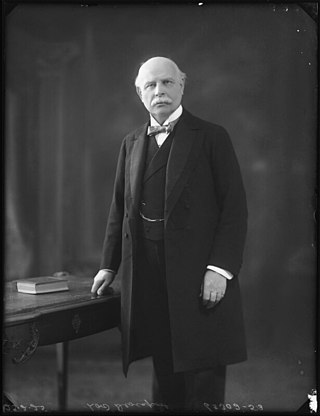
Hudson Ewbanke Kearley, 1st Viscount Devonport,, styled Lord Devonport between 1910 and 1917, was a British grocer and politician. He founded the International Tea Company's Stores, became the first chairman of the Port of London Authority, and served as Minister of Food Control during World War I.
